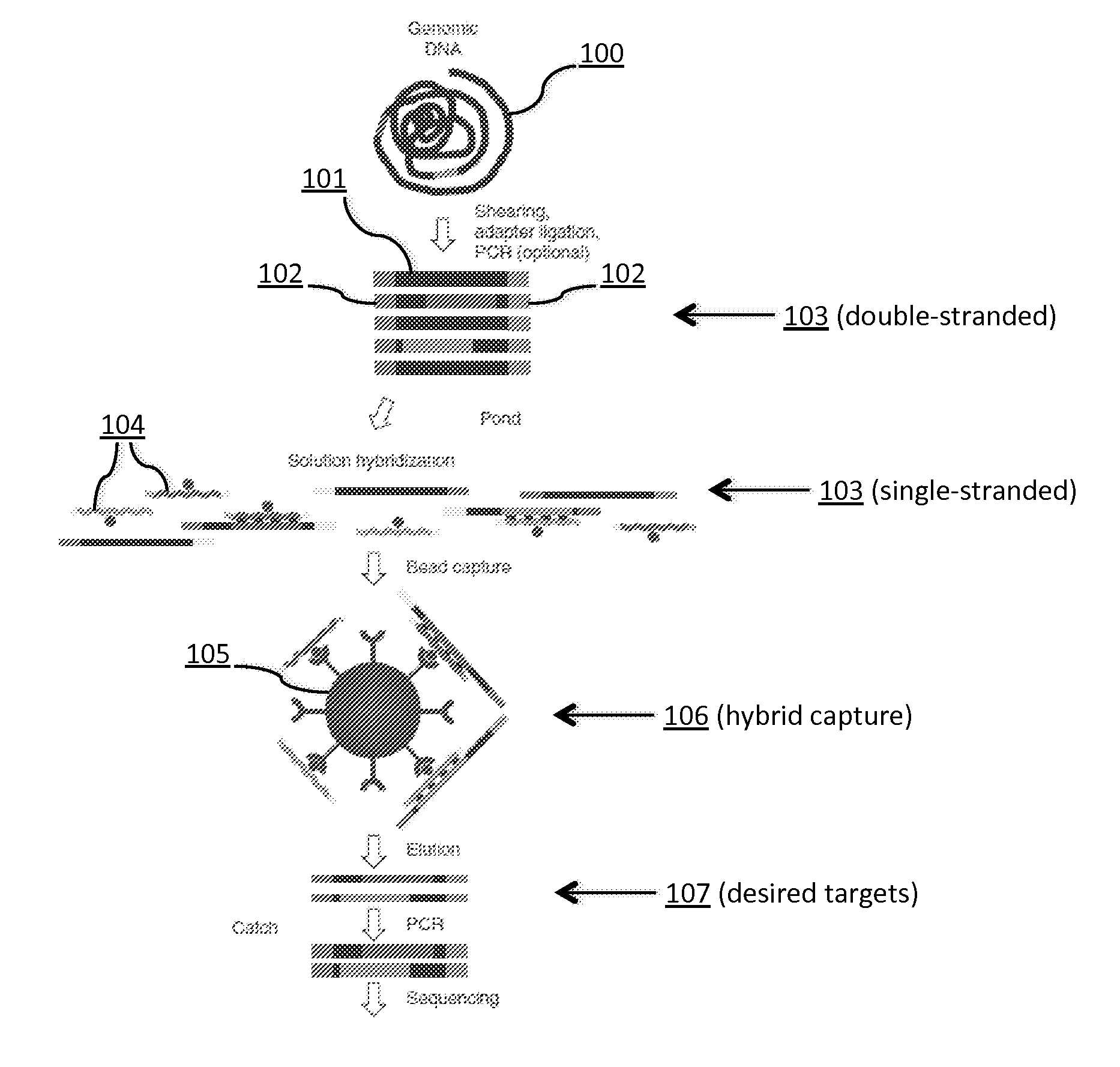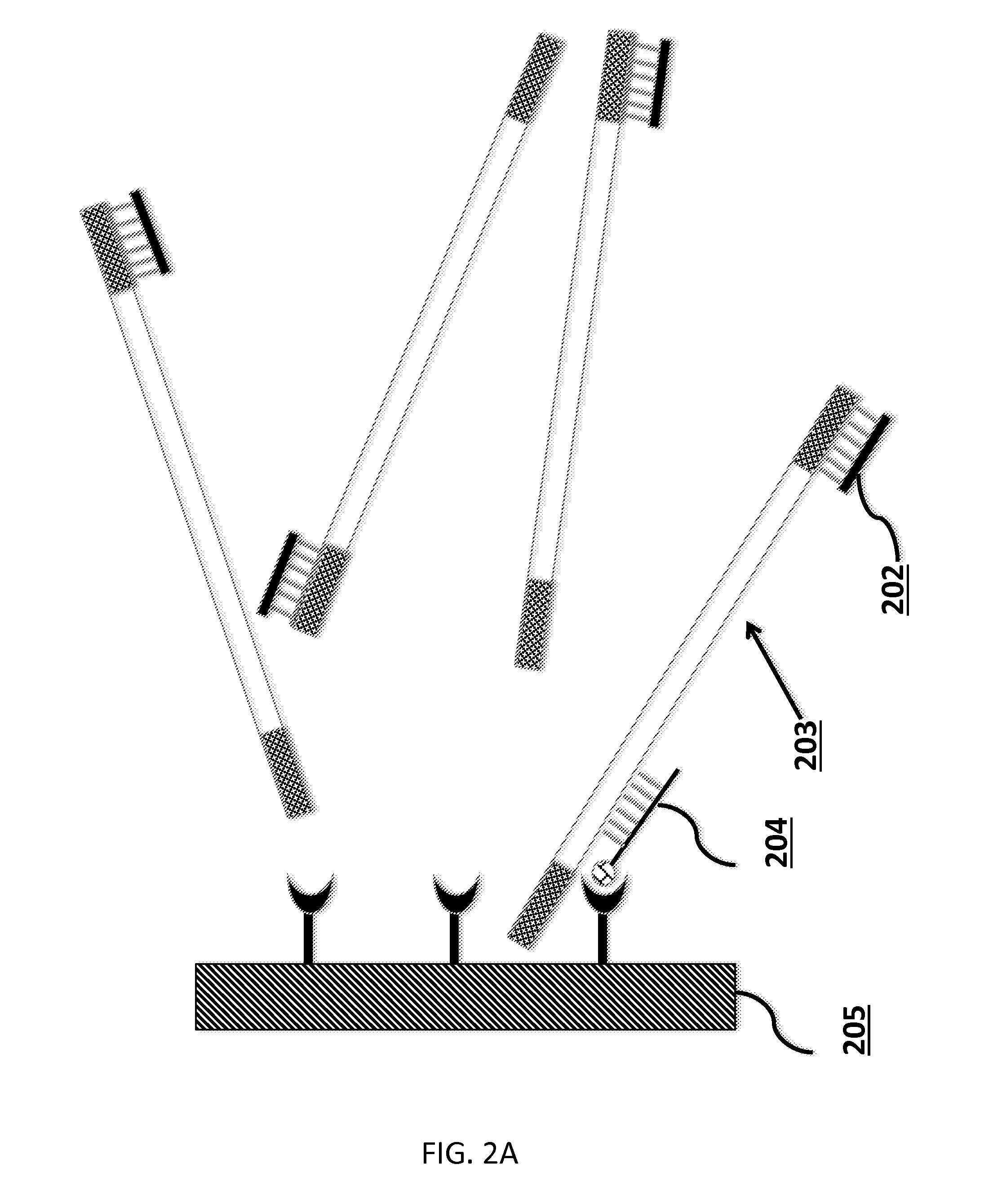Tm-enhanced blocking oligonucleotides and baits for improved target enrichment and reduced off-target selection
a technology of enhanced oligonucleotides and baits, applied in the field of modified oligonucleotide compositions, can solve the problems of large fraction of unwanted sequences present unwanted ngs templates that are recovered, and large fraction of unwanted sequences that remain in the enriched pool, etc., to enhance/reduce relative target coverage depths, modification/shortening length
- Summary
- Abstract
- Description
- Claims
- Application Information
AI Technical Summary
Benefits of technology
Problems solved by technology
Method used
Image
Examples
example 1
Hybridization of DNA Probe to the Capture Products
[0455]The procedure below summarizes the steps necessary for hybridization of the DNA probe with the capture products.
A. Hybridization
[0456]One hundred nanograms of pooled biotinylated baits, 500 ng of adapted DNA library, 2 μg Cot−1 DNA, 2 ng of oligonucleotide blockers 2.0 μL is combined into a volume of 10 μL and mixed with 10 μL of pre-warmed Genisphere Buffer 6 (2×SDS-Based Hybridization Buffer: 0.50M NaPO4, 1% SDS, 2 mM EDTA, 2×SSC, 4×Denhardt's Solution). Following vortex mixing of the mixture, an overlay of 40 μL mineral oil is applied and the mixture is denatured in a thermocycler at 95° C. for 5 minutes with a slow decrease to 71° C. The mixture is incubated at 71° C. for 48 hours.
B. Binding to Streptavidin beads
[0457]The streptavidin beads are prepared in the following manner before addition to the hybridization mixture. The streptavidin beads are allowed to sit at room temperature for 30 minutes. For each hybridization re...
example 2
PCR Reactions with Single-Stranded Template Material
A. Final PCR Enrichment
[0461]The recovered single-stranded templates (16 μL) are prepared to a total volume of 50 μL with the following reaction mix components (KAPA HiFi master mix (25 μL); 25 μM Primer 1 (l μL), 25 μM Primer 2 (l μL), Water (7 μL)). The DNA is vortexed briefly and recollected as a solution following brief centrifugation. The reactions are placed into a thermocycler with the following program: 98° C. (45 sec); 98° C. (15 sec); 60° C. (30 sec); 72° C. (30 sec); 77° C. (30 sec) for five or more cycles. The amplified products are purified with AMPure beads using 1.5× volume and eluting in 20 μL EB Buffer (Qiagen) (10 mM Tris-HCl, pH 8.5). The resultant concentration of the DNA is measured with a Quibit Fluorometer and diluted for use with the appropriate NGS sequencing platform.
[0462]Five cycles of amplification are used for post-capture Ion Torrent libraries and typically not more than 18 cycles of amplification are...
example 3
Tm-Enhanced Oligonucleotides for Use in the Illumina Sequencing Platform with Inosine Bases for Barcode Domains
[0463]In Table I, the following blocking oligonucleotides were designed for use in hybrid capture experiments for DNA template libraries with the Illumina sequencing platform. The Tm-enhanced oligonucleotides were prepared using LNA (“+C” or “+A”) or BNA (“ / iBNA-meC / ” or “ / iBNA-A / ”) as Tm-enhancing groups. All oligonucleotides were prepared using phosphoramidite chemical methods. Tm values are estimated for LNA bases in 750 mM NaCl buffer (similar ionic strength to 5×SSC) and for 15 mM NaCl buffer (similar ionic strength to 0.1×SSC) using the method of Owczarzy (Biochemistry 2011 50:9352-9367), which is incorporated by reference in its entirety. The BNA modification has similar thermodynamic effects as the LNA modification, so the predictions presented herein apply to both classes of modified blockers and LNA / BNA modifications can be substituted in all examples. For example...
PUM
| Property | Measurement | Unit |
|---|---|---|
| Tm | aaaaa | aaaaa |
| nucleic acid melting temperature | aaaaa | aaaaa |
| nucleic acid melting temperature | aaaaa | aaaaa |
Abstract
Description
Claims
Application Information
 Login to View More
Login to View More - R&D
- Intellectual Property
- Life Sciences
- Materials
- Tech Scout
- Unparalleled Data Quality
- Higher Quality Content
- 60% Fewer Hallucinations
Browse by: Latest US Patents, China's latest patents, Technical Efficacy Thesaurus, Application Domain, Technology Topic, Popular Technical Reports.
© 2025 PatSnap. All rights reserved.Legal|Privacy policy|Modern Slavery Act Transparency Statement|Sitemap|About US| Contact US: help@patsnap.com



